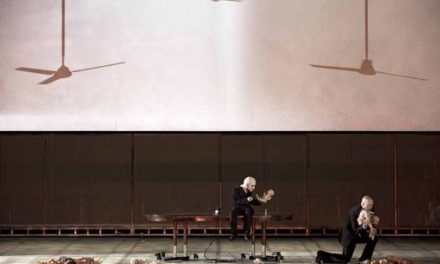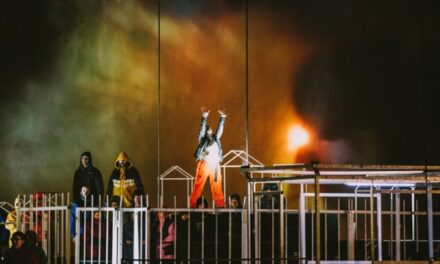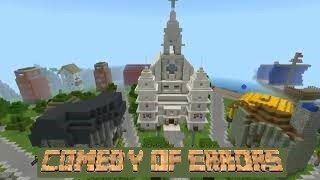Performance Between the Real and the Virtual: The Odiseo.com Project
I will focus here on the experience of Odiseo.com, a performance I directed, which brings together three actors in three different countries using Skype. It tells the story of a contemporary Ulysses who, while in Buenos Aires, finds his affections divided between Laura (Penelope) who lives in Bremen, Germany, and Elisa (Calypso) who resides in Florianopolis, Brazil. The focus of this research was the actors’ interaction through Skype, and the intimacy of the reception. This allowed us to experience both distance and proximity on fictional and real levels.
The Mise-en-Scène in Brief
The one-hour long performance unfolds in three different places: a home in Bremen during the early morning hours, the living room of an apartment in Florianopolis, and a rehearsal room at the Theater CELCIT in Buenos Aires, where a replica of a hotel room has been mounted.
Spectators at each of these three locations have a different perspective on the show. While in Bremen the experience is one of sharing a small apartment with a family, in Florianopolis spectators sit on chairs arranged for this purpose in the living room of an apartment while an actress moves through the rooms in a highly intimate performance. In Buenos Aires, the actor is exposed to the gaze of the spectators who surround him on all sides in a fifty-square-meter room.
Ulysses speaks with his wife and mistress via Skype in real time. The performers interact with each other for one hour in an on-going triangular relationship between a businessman who is constantly traveling, his mistress, and his wife. Unwilling to wait for him indefinitely, the two women press him to make a decision and return to what each of them considers to be his home. What we see on stage is a long-postponed crisis that is resolved right before our eyes.
Though one of its outstanding features is the use of Internet-based communication, the project was not conceived as an opportunity to experiment with virtual technology in the creation of a play. Rather, it was born out of the shared desire for collaboration between actor Juan Lepore and me. Living in different cities, and unable to find the time and resources to travel and get together, we found ourselves talking via Skype, and this tool soon revealed its potential as a creative element of the show.
The use of conference calls to participate in a creative process is not new for me, for I reside in a non-central city in Brazil. Working on Skype allows me to collaborate with theater groups from other cities without the need to travel constantly. However, engaging several people in different geographic locations at the same time gave the Odiseo.com project an altogether different perspective. From the beginning of the project, we began to deal with the many elements that make up the communication mediated by Skype during the processes of discussion and creation. These elements would then be incorporated in the dramaturgy of the play. As soon as it became evident that it was possible to organize a performance in which actors interacted with each other through the Internet, we began to discuss the script and decided to invite Chilean author Marco Antonio de la Parra to write the play for us. De la Parra used The Odyssey as a starting point to work with distance as the subject matter of the project. The distance between director, actor, and actresses also became the distance between the characters; and travel as a theme was suggested by the international nature of the project–and especially by the life experiences of the author, an actress, and the director.
The use of electronic devices became crucial to the proposal since the distance between project participants conditioned the whole creation process, as well as the presentations. Since the project involves different countries, in addition to experimenting with virtual tools, we had to deal with the issue of language. We readily chose Spanish, which enhanced the international character of the proposal. Working with Skype helped lower the project costs since it eliminated the need for constant trips between the three countries.
One fundamental instrument of the staging was the use of television screens to display what was happening in other countries, which meant that, at each location, spectators–depending on their position–were exposed to a more or less realistic scene, in which the use of Skype was part of the characters’ everyday life.
During the presentations we soon realized that in addition to the first level of reception–i.e., the interaction between actors and spectators in their respective rooms–there was a second level of interaction between the viewers and the characters that appeared on TV screens, at the moments when it was also possible to observe how the audience in one place perceived the reactions of the audience in the other places. As the actors moved through their spaces carrying their computers or iPads, viewers in one country were able to see their counterparts in another country, which elicited surprise and exhilaration from a feeling of shared experience. As opposed to what happens in a traditional theater, spectators were at times exposed to the gaze of other spectators, whose reactions could also be heard–albeit out of sync, which incited laughter and comments.
Though at first there was a temptation to reach a larger audience by streaming the show, we eventually decided that this would go against the language that had been developed. The use of Skype was intended as an instrument to propitiate a sense of reality in the field of virtual communication, and we felt that a streaming transmission might create a very different reading from the one that had emerged from the rehearsals. This naturally limited the number of viewers to the capacity of each location.
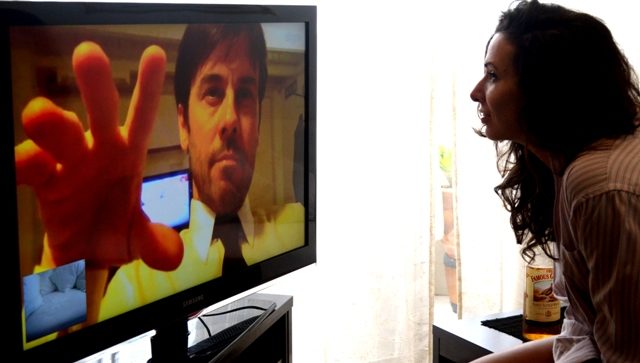
odiseo.com, Andre Carreira
The Virtual and Simulation
In this creative experience we were confronted with notions of space and time and how our certainties about these notions become dissolved in the current virtual world. This was true both for the actors and for the audience, which needs to decide what is real or simply fiction–a game between the characters. As Tonezzi and Schulze affirm:
The use of new technologies gradually imposes unprecedented parameters of conceptualization and signification on that which was conventionally called scenic space and presence. This involves more than just a simple search for mimetic effects or pure simulation/representation of environments, characters or beings from daily life, but the creation of specific meanings and locus, which is allowed by Internet communications, in which these instances gain autonomy and interfere in perception, in relationships, in understanding and consequently in the role of the spectator [1].
For both the actors and the spectators there is a change in relation to the perception of space and time. By working with the Skype media we create doubt about what is real and what is simple representation for the camera. Each actor constructs a scene that is offered to the others as a construction of a moment of their respective characters. The screens in the different cities allow the spectators to see the same information as the characters, and to witness the procedure of construction that the character in their city offers to the others. Thus, the spectators have intimate contact with the actor and actresses, and can simultaneously discern the constructive logic that permeates the conversation through the media.
It is also important to remember that the use of Skype communication is part of the cultural universe of the spectators. This interplay is important in the construction of the environment of the spectacle, because by developing the scene with Skype, Whatsapp and cell phones, we interfere in the perception of time of the scene, given that this allows spectators to imagine the possible invisible procedures that can be used in the production process. The spectators have a command of these communication instruments, which are part of their daily lives, but, in Odiseo.com these instruments are transformed into objects of fictional language. This establishes closer ties between the artistic action and the audience. Simultaneously, the spectators can perceive the reactions of the spectators who are in other countries, so that the effect of dialogue is extended with the construction of an imagistic reality.
This experience certainly raises the possibility that the spectators question if the actors are truly in three countries. Why couldn’t they be in spaces that are close by, yet simulating distance? Is it important that they are in three different countries? How does this change the artistic experience? First, it is worth reiterating that the use of Skype was born from our effective desire to conduct a spectacle despite the distance that separated us. The spectators have been informed that the actors are in different countries, but we do not focus on this condition, but on the distance between the characters–the distance between the actors and the consequent technological problems appear as secondary information.
By accepting the fact that the actors, and therefore the characters, are separated in different countries gives potential to the narrative, but at the same time, creates a space for interplay because the spectators can question the procedures of a staging that interconnects three countries. It should be remembered that everyone is aware of the possibility that a Skype connection can fail, that the images may freeze or lose clarity. This tension represents a productive element of the spectacle because it incorporates the unpredictable into the scene, and requires the actors to maneuver the time to give continuity to the scenes, which can also modify the theatricism in the eyes of the spectators.
By using Skype, we work with an expanded notion of the idea of presence. In this sense, it is interesting to consider the point of view of Rubens Velloso, who affirmed that there are various forms of presence with which the contemporary scenes work.
According to Velloso, we have the “Surface of Events,” represented by the plane of ideas formed by different conceptual and artistic flows (these flows include the word, the body, the image, the Internet connections and the digital and computer arts). This gives shape, in a rhizomatic manner, to an aesthetic/ethical/reflexive surface.
The “MC of flows” interferes on this “Surface” (which is different from the traditional idea of actor and spectator), which would be the receptors, interpreters, and transmitters of the flows that emerge from the surface of the events. These agents are always transmuting their states and appropriating all the corporal and mental forms that they can use for entangling the plane of ideas. Finally, there is the dramaturgy, which is the code developed, that is specific for each work so that the “MCs” can address them in the events of the surface. The dramaturgy is not constituted solely by the word. [2]
We turned to the work of philosopher Merleau-Ponty to give meaning to this. His work Phenomenology Of Perception provided us tools for thinking of ourselves as temporal beings endowed with a notion of time, affected by the very history we make, conscious of our past and future, and aware of death. We are also spatial beings, cognizant of space in its different dimensions, living in a world composed of places.
We are spatial and temporal beings, says Marilena Chauí, reflecting on Merleau-Ponty: “Our body is a sentient being aware of itself; it is a way of being in the world.”[3] However, when time and space references are no longer at the center of our experience–as happens on the Internet and in the virtual world–we are forced to rethink all our relationships. Internet communications give us a sense of a dual world, which creates the possibility of an individual’s duplications (real and virtual). However, the concrete relationships are determined by events between bodies in space.
Brazilian researcher Ana Maria Bulhões affirms that:
In contrast to theater with the exclusively carnal and concrete presence of the actor, based on the incorporation of the technological innovations specific to digital languages, the opportunity for the participation of the actor and of the public in a spectacle to become semi-live or totally virtual becomes real and possible. This was unthinkable before the installation of a digital culture that in some way affects all of the creative fields. Contrary to a rejection of technology, moving toward a proposal for new poetics for scenic performance, since the second half of the 20th century we have witnessed demonstrations that the scenographic applications of the new technologies create opportunities to generate new paradigms for the scene. When the pendulum moves toward the valorization of sophisticated devices, the scenography gains a presence and its effect will be more than “to make live” what is represented.[4]
The dissolution of space and time creates a condition marked by placelessness and achrony (absence of time), an increasingly more common experience today, which our cultural habits naturalize. We live in an era in which we no longer marvel at the fact that we can talk to someone on the other side of the planet, sharing images and data simultaneously, or at our capacity to build a world of information through websites and blogs.
In the face of all this, can we deny the existence of a virtual world that runs parallel to the “real” world? The virtual world, as we perceive it, seems defined more by what it hides from our senses than by what it reveals. If virtual reality shortens distances, speeds up processes, and facilitates contacts, it does so by disseminating a “deluge of information flows,” to use Pierre Lévy’s expression.[5]
Our reflections on the performance focus on these assumptions. As art critic Edélcio Mostaço puts it, Odiseo.com creates a very peculiar privacy policy where “Everyone can see everything, but nobody can do anything.”[6] A key element of the show is the discussion about the construction of realities through Internet communication devices, and how in our daily lives we tend to accept them as true, in spite of the fact that they are always edited, framed by screen boundaries. We worked with the idea that, in principle, people consider their conversations via Skype as faithful representations of what is true about their relationships. Odiseo.com seeks to question these assumptions–or to at least convey a double meaning about the intensity of mediated experiences related to a sense of closeness in distance, because computer screens simultaneously offer a sense of intimacy and the possibility for presenting edited images as a media discourse. The play also challenges the perspective of intimacy brought about by the proliferation of virtual media, particularly the so-called “social network” platforms.
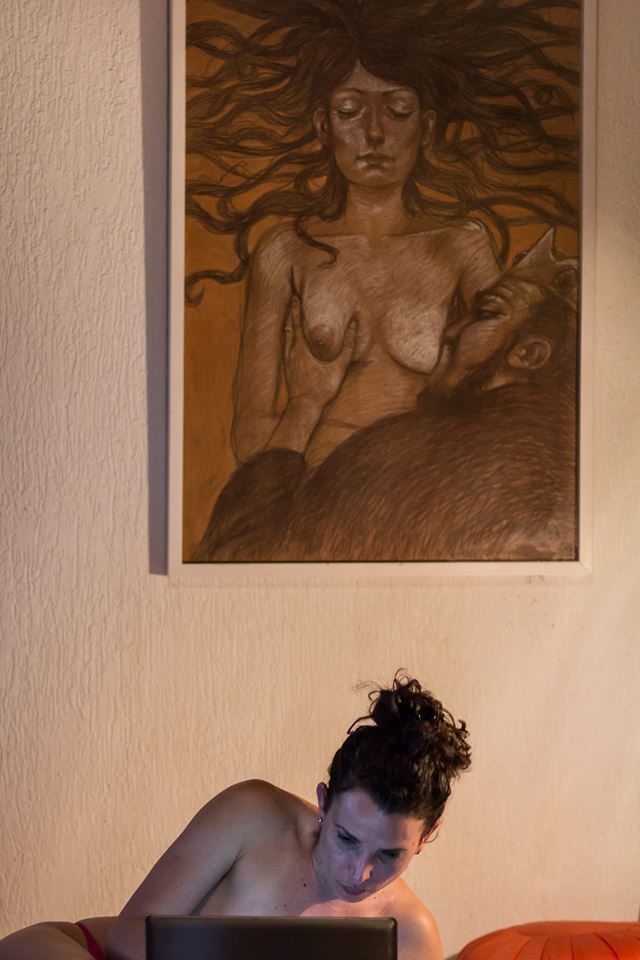
odiseo.com, Andre Carreira
By working with intimacy and interface through Skype, Odiseo.com dialogues with the shift of the theatrical paradigm because it reveals the discussion of the phenomenon of presence on two levels–the fictional, but also the reality of the representation itself. We are not surprised by the fact that there is an acceptance that the actors are distant from each other, and that the scene truly occurs in three different countries. The very idea of theatricality is supported by a concept of an expanded scene in which the notion of unity of place dissolves to emphasize the unity of time, but always considering the narrative constructed by the spectators who accept this unity, believing in Skype as an instrument of approximation “whose key elements are multiplicity, simultaneousness, and speed, [which] alter the perception and conventional understanding of time, body, and space.”[7]
In virtual reality, the human body finds an extension of itself above and beyond spatial constraints. A series of moves in this direction had already been attempted since the Industrial Revolution, through earlier communication and transportation networks. With the advent of computer technology, the progress was exponential. Currently, our brain can project itself through space and time, demolishing boundaries, to the point of abolishing these categories altogether. The fact that the universe is online twenty-four hours a day [8] implies a change in perception of both space and time, as well as of our place in this new universe.
Nevertheless, it is impossible to face the virtual world without being confronted by its ambivalence: in bringing things closer, it creates a false sense of closeness. Pierre Lévy sees the virtual world as a “de-territorialized entity,” and emphasizes its “ability to produce concrete manifestations at different times and at certain places, without being itself tied to a particular place or time.”[9] This is a world in which the concrete appears once more as “hearsay,” where the material is but a perception, an acceptance, a shared construction. Though this may reaffirm the sense of the virtual–since we are now content to think of our world as a construction and not as something given and external to our perception–we cannot help suspecting the veracity of things and information. Given the suspicious times we live in, it is natural that we question the ability of the virtual world to offer us a life filled with the relationships we crave for.
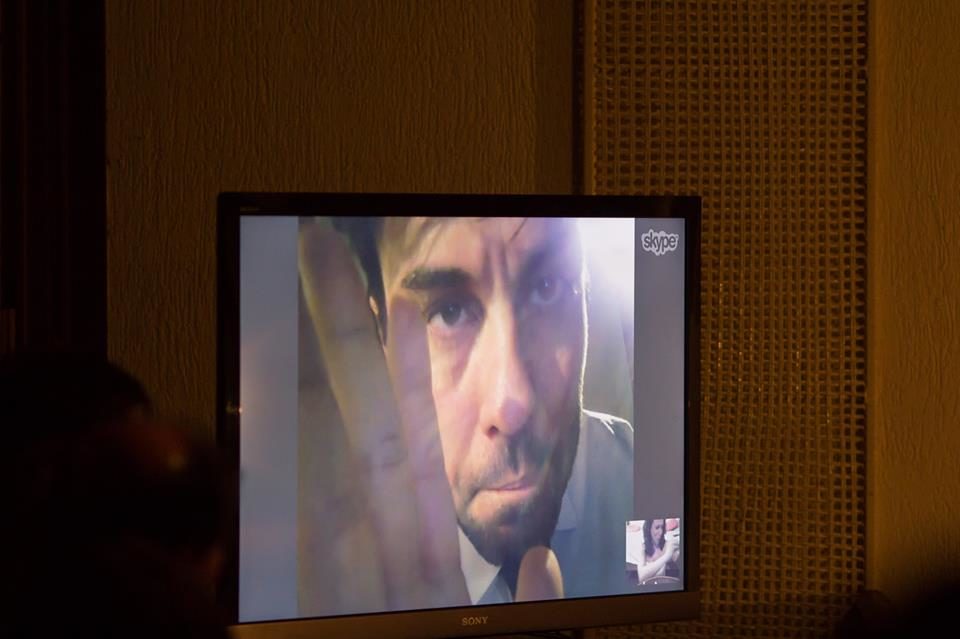
odiseo.com, Andre Carreira
Odiseo.com addresses this problem from the first scene, in which everyday life is represented with a high level of realism. In the Brazilian location, for example, we decided to use a residential apartment with only a minor modification in the dining room in order to install seats for the viewers-turned-voyeurs. They find themselves in someone else’s home witnessing a moment in the life of a woman who is the mistress of a man who finds himself in a hotel in Buenos Aires. The spectators are very close to the woman’s movements, and can also see the characters at the other locations of the performance on a large TV monitor.
Witnessing Elisa’s routine as she talks to her lover, bathes, and talks with her mother and friends, viewers realize that what they see is different from the reality conveyed to her lover on Skype. Though this difference establishes an element of humor, it is mainly an ideological component of the show.
The dialogue over Skype is a simulation articulated as though it were a real contact. Equipped with image and sound, and the ability to move through space–since the iPad is portable and works with a wireless signal–the virtual chat allows, as Pierre Lévy observes, “a person to explore more complex models and in greater numbers than if they were reduced to the resources of their mental imagery and short-term memory,”[10] This simulation works simultaneously on two levels: on one hand it offers itself as an image of reality, and on the other, it assumes a narrative action as it selects the information and images that are to be transmitted. The use of the camera presupposes the editing.
Although communication via Skype offers a more interactive experience than telephone communication, the live image compromises the participants’ bodies and limits the spectrum of actions that can be performed simultaneously. However, once the camera angle has been established, it is possible to engage in multiple activities, as long as the screen shows an image on which the dialogue can concentrate. In spite of having an image as its distinctive feature, this type of communication via webcam precludes eye-to-eye contact, which is one of the fundamental elements of interpersonal communication. When we want to look at our interlocutor we must focus on the camera, and thus we cannot look the person in the eye. What we get on the screen is an image at a different angle–a symbolic mismatch in conversations via Skype, no doubt, which new technologies are trying to solve.
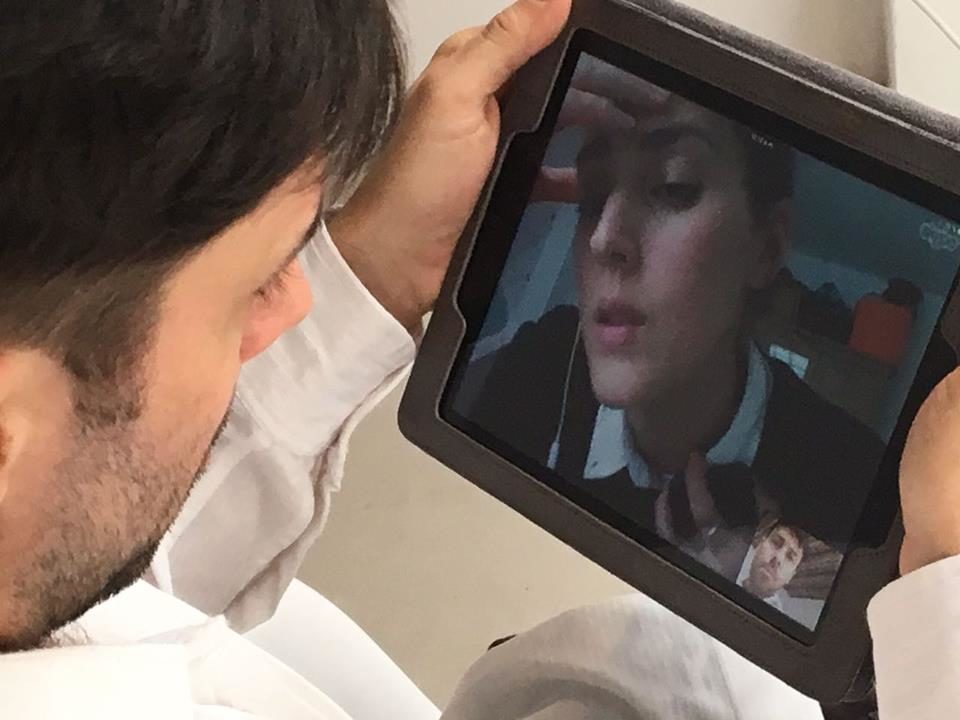
odiseo.com, Andre Carreira
When what we see on the screen is a hand indicating that contact is not possible at the moment–as in contacts between jailed criminals and their visitors, we are being told how in virtual communication we must develop a repertoire of actions and gestures if we are to convey meaning to the other party (i.e., some degree of representation will be required). For the younger generations, born in a time of virtual communication, it is natural to use communication devices such as writing in UPPER CASE letters to convey a sense of volume or enthusiasm, or to perform specific movements in front of the camera to emphasize the information. Communication procedures are intensified, and the artificial has become the preferred tool. To convey a sense of reality through the Skype video, we must expand our repertoire of gestures and carefully dramatize what we intend to be read as real.
The Process of Testing: The Virtual and the Intimate
Having considered the features of a performance that converses with the virtual world, I will now reflect on the rehearsals. Given the condition of spatial separation inherent to the project, the rehearsals had to follow a unique process. Though we worked personally in Brazil and conducted some rehearsals in Buenos Aires, the base of the rehearsal process was the Skype platform.
Our rehearsals combined procedures common to theater with image-capture techniques used in cinema and television. Working with Skype meant that we constantly had to deal with interruptions in communication, signal delays, and the freezing of images. Therefore, to maintain the rhythm of communications, apart from the Skype platform on the stage, we resorted to text and Whatsapp messages on our mobile phones. This led us to think of rehearsals in more than one way, which directly influenced the construction of the final play, as well as the script. To ensure synchronicity between the three countries, a support team of two technicians–one in Buenos Aires and another in Florianopolis–maintained constant communication throughout the performance using a private Skype account and the Whatsapp group contact modality.
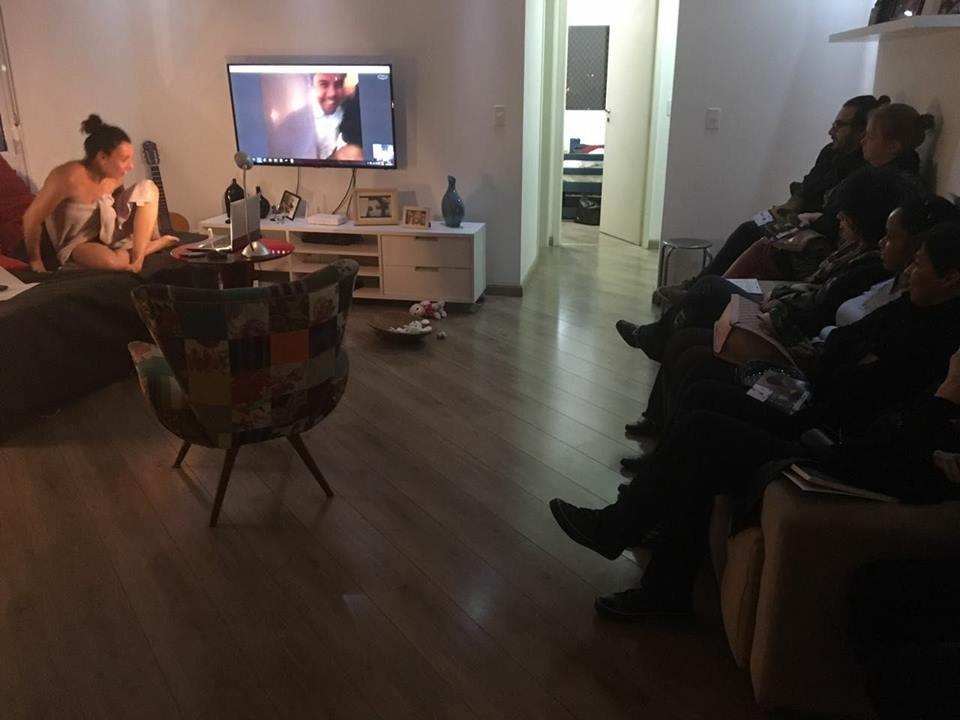
odiseo.com, Andre Carreira
Rehearsals on Skype forced us to use a support camera–with all the characteristic limitations of Internet cameras–to maintain control over the whole staging area. In this way, it was possible for me to see the scene in Brazil, follow the images on Skype as they entered it, and watch the Buenos Aires scene almost as a spectator would in the room. However, limitations in image quality made it necessary to move the camera to follow the actor, as though it were the director’s eye. This was made possible through the collaboration of an assistant who handled the camera and commented on the scene simultaneously.
Working from these two angles (perspectives) made it possible to adjust the intensity of the actor’s work in Buenos Aires–assuming a place in his local audience–while articulating the possibilities for his image as projected in Brazil and Germany. The use of at least two computers at each location offered two viewpoints from which the development of the scenes could be followed.
The actors faced great difficulty in trying to shape their image through video while preserving their relationship with the gaze of the audience at their respective places. It must be said that the team of actor and actresses, though experienced in theater, had little practice in film and television, and thus little command of video language. Though all of them knew how to Skype, their experience was limited to private conversations. Although the Skype voice-and-image session screen shows the images of both parties (with the caller usually appearing in a small frame at the lower right-hand corner of the screen) it is hard to tell how viewers at the various locations perceive each other’s performances. In real life, this small picture–which represents the actual area covered by the camera–helps the caller modulate the information they want to convey during a conversation, and it became instrumental in building scenes throughout the play. In one of them, for example, Elisa simulates a suicide attempt with alcohol and pills by placing a bottle of whiskey and a jar of pills within sight of the camera and approaches the lens to show her face dazed by the effect of alcohol.
This scene is an example of the duplicity of realities brought about by technology. While viewers in Brazil could see the whole process of mounting the scene, and how the character was framing its appearance, in Buenos Aires the image presented left out all that information, conveying a truer texture to the suicide simulation.
The improvisational character of the performance was directly related to the technology used. As mentioned earlier, the script was written on demand once the communication modality and the three locations had been defined. Since Skype was an essential part of the project–at some point we even thought of naming it Ulises.skype, but dropped the idea due to copyright issues–we knew we could expect a lot of improvisation. We planned to begin using Skype and from there let the actors synchronize dialogues over the Internet. However, the structuring element of the text was instrumental for the staging, as it increased the opportunities for improvising because of the element of chance inherent to an Internet connection. Hence we had two action plans for the rehearsals: the memorized text, which marked the duration of each block of scenes and the synchronicity between the locations; and the improvisation that arose either because of communication glitches or during those lapses without Skype in which the scenes turned more inwardly into the characters. During rehearsals, we even provoked deliberate interruptions to push the search for solutions to the extreme, both in technological and interpretational terms, within the scene and among the performers.
During the presentations, we discovered that the handling of the technology as a dramaturgical element produced empathy with the viewers, who recognized the accidents and difficulties involved and created expectations among them of how things would be solved. During rehearsals, we thought of testing different teleconference platforms to achieve a more stable connection, the best sound, and the clearest picture. However, the Skype option guaranteed a less theatrical dimension, since it kept viewers in touch with daily life and an easily identified platform. By working with a tool that was well-known to our viewers, we were able to explore both the element of reality inherent in the unpredictable character of the Internet and the fictional component in human relations mediated by virtual communication. We received enthusiastic feedback from some spectators who said they had seen on stage something very similar to their own emotional experiences.
Working with virtual presence as an element of the mise-en-scène meant that our play would reveal the existing tensions between live performance scenes and their unfolding on the screen. Therefore, to offer the audience as intense an experience as possible, we sought to maintain a close proximity between viewers and performers; and to exacerbate the sense of intimacy we decided to use nudity. In the first scene in Buenos Aires, as viewers enter the space, they see the naked actor sleeping in his hotel bed. Similarly, in Florianopolis there is an entire scene in which the character enters the shower and emerges naked to fetch a towel she has forgotten in the service area and begins a conversation with Ulysses without getting dressed. She even masturbates in a very realistic virtual-sex session. The actress in Germany, who was actually pregnant, exposed her belly while talking about her marriage crisis with Ulysses, and later presented her newborn daughter to the audience as another character. The feeling of being in the space of the Other–and, moreover, of having this Other exposed–would hopefully imbue the audience with a sense of being in contact with something pertaining to the realm of the real–or, at least a need to question the reality of the material presented in the scene. The sense of reality stemmed mainly from the proximity to intimate spaces.
Combining the virtual element with a witness-like position in an undeclared situation was part of a game that sought to seduce the spectator’s gaze. The project built a ludic space in which viewers experienced intense sensations related not only to the development of the narrative but also to the way performers interacted with the electronic media. In this regard, at each location, viewers found themselves in an environment that bore little resemblance to the traditional sitting arrangement away from the scene. Proximity was a key element in the construction of each scene and the selection of images. We insisted on intimacy, especially in the exposure of the actors and actresses’ bodies, to facilitate a tension with the images conveyed by television screens.
Odiseo.com attracted both audiences and the media, partly because of its perceived novelty, even though we were not pursuing novelty during the creation process. However, this condition encouraged us to deepen our own relationship with the technical materiality of the show, which in turn affected the development of the performance.
virtual presence, mise-en-scène
Notes:
[1] Tonezzi, José and Guilherme Schulze. “Cena, Tecnologia e Inovação: desaios para a formação e a pesquisa em artes do espetáculo,” Moringa, vol. 2, no. 1, January / June 2011, p. 54.
[2] Velloso, Rubens. “Cena Contemporânea e Tecnologia,” Moringa João Pessoa, Moringa, vol. 2, no. 1, January / June 2011, p. 81-89, p. 84.
[3] Chauí, Marilena. “Espaço, tempo e mundo virtual – A contração do tempo e o espaço do espetáculo,” Conference at CPFL, Campinas, 13 October 2014 (unpublished), p. 37.
[4] Bulhões-Carvalho, Ana Maria. “Longe é um lugar que não existe: discussão de portas abertas entre (novo) teatro e (novas) tecnologias,” Moringa, vol. 2, no. 1, January / June 2011, p. 61-70, p. 62.
[5] Lévy, Pierre. Cyber Cultura, trans. Carlos Irineu da Costa, Editora 34, São Paulo, 2009, p. 12.
[6] Mostaço, Edélcio. “Odiseo.com: crítica da peça,” Questão de critica, Revista electrônica de criticas e estudios teatrais, vol. 7, no. 63, December 2014, <http://www.questaodecritica.com.br/2014/12/odiseo-com/>.
[7] Tonezzi, José and Guilherme Schulze. op. cit., p. 53.
[8] Chauí, Marilena. “Espaço, tempo e mundo virtual – A contração do tempo e o espaço do espetáculo,” Conference at CPFL, Campinas, 13 October 2014 (unpublished).
[9] Lévy, Pierre. op. cit., p. 47.
[10] Ibid., p. 89.
References
Bulhões-Carvalho, Ana Maria. “Longe é um lugar que não existe: discussão de portas abertas entre (novo) teatro e (novas) tecnologias,” Moringa, vol. 2, no. 1, January / June 2011, p. 61-70.
Chauí, Marilena. “Espaço, tempo e mundo virtual – A contração do tempo e o espaço do espetáculo,” Conference at CPFL, Campinas, 13 October 2014 (unpublished).
Lévy, Pierre. Cyber Cultura, trans. Carlos Irineu da Costa. São Paulo: Editora 34, 2009.
Merleau-Ponty, Maurice. Fenomenologia da percepção, trad. C. Moura. São Paulo: Martins Fontes, 1994.
Mostaço, Edélcio. “Odiseo.com: crítica da peça,” Questão de critica, Revista electrônica de criticas e estudios teatrais, vol. 7, no. 63, December 2014, <http://www.questaodecritica.com.br/2014/12/odiseo-com/>.
Tonezzi, José and Guilherme Schulze. “Cena, Tecnologia e Inovação: desaios para a formação e a pesquisa em artes do espetáculo,” Moringa, vol. 2, no. 1, January / June 2011.
Velloso, Rubens. “Cena Contemporânea e Tecnologia,” Moringa, vol. 2, no. 1, January / June 2011, p. 81-89.
This article appeared in Archee on November 12, 2018, and has been reposted with permission.
This post was written by the author in their personal capacity.The opinions expressed in this article are the author’s own and do not reflect the view of The Theatre Times, their staff or collaborators.
This post was written by Andre Carreira.
The views expressed here belong to the author and do not necessarily reflect our views and opinions.


